INTRODUCTION
[1] The United States of America is exceptional in many ways. This includes the fact that there are more guns (c. 400 million) than people in the country (332 million) and that we have more gun violence than other high-income nations. Many draw a clear line between more guns and more gun violence. I argue that such a simple correlation may be true as far as it goes, but it does not go very far. It fails to properly understand the culture of guns in America, the reality of gun violence, and the relationship between the two.
[2] In this essay, I will explain my understanding of gun culture and violence by presenting evidence that corrects prevalent misunderstandings in order to suggest some paths forward for reducing criminal violence and self-harm in ways that do not unnecessarily burden those for whom guns are unproblematic.
GUN CULTURE PROPERLY UNDERSTOOD
Misunderstanding #1: The gun industry created gun culture
[3] In Arming America: The Origins of a National Gun Culture, historian Michael Bellesiles argued that private gun ownership was rare in Colonial America and the early republic, that colonists did not like and rarely used guns, and that American gun culture only really emerged around the Civil War when firearms became more affordable and more heavily marketed by gun manufacturers. The book resonated with critics of American gun culture and was awarded the prestigious Bancroft Prize for American history. The research upon which these claims were based, however, was subsequently shown to be falsified. Bellesiles resigned from his tenured position at Emory University and his Bancroft Prize was rescinded.[1]
[4] Bellesiles’s experience notwithstanding, the claim that gun culture is a creation of the gun industry has been repeated by historian Pamela Haag in The Gunning of America: Business and the Making of American Gun Culture and gun industry whistle-blower Ryan Busse in Gunfight: My Battle Against the Industry that Radicalized America.[2]
[5] To be sure, firearms are commodities manufactured by profit-seeking organizations in our capitalist economy. These companies have a vested interest in selling their products. But the gun industry does not create gun culture any more than the golf industry creates golf culture or the automobile industry creates car culture. All industries seek to create demand for their products and so drive culture, but they also respond to demands in the marketplace that reflect a pre-existing culture. Thus, it is better to understand the gun industry as a part of, not apart from, gun culture.
Understanding: Guns have been a common and normal part of American life from since the colonial period
[6] Before there was a gun industry, there were guns in the US. When the first colonists arrived at what would be called Jamestown in 1607 and Plymouth Rock in 1620, they had guns at the ready. Firearms continued to be commonly owned (by those who could legally do so) in the run-up to the colonists’ Declaration of Independence from the British Crown and the nation’s Constitutional founding. One reliable estimate of ownership rates in early America found firearms in 50 to 73 percent of male estates and even 6 to 38 percent of female estates. These rates compare favorably to other everyday items listed like swords or edged weapons (14% of estate inventories), Bibles (25%), or cash (30%).[3]
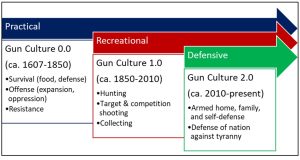
[7] The diagram above is a heuristic device for understanding the evolution of gun culture in the U.S. from the colonial period to the present, highlighting the core emphasis of gun culture in different broad time periods. At any point in this history, gun culture is diverse. Today, for example, defensive gun culture is dominant but recreational gun cultures still exist and some own guns strictly for practical purposes like vermin control on farms.[4]
[8] In the beginning, firearms were practical tools of necessity for hunting, personal and family protection, and expansion into a frontier that indigenous peoples were defending. Of course, survival was not the only practical use to which guns were put in the Colonial and settler-colonial eras. Guns were also offensive tools used to maintain the oppression of enslaved people throughout the colonies and against Indigenous peoples to facilitate westward expansion. And guns were tools of resistance to tyranny in the form of the British crown.[5]
[9] As historian Clayton Cramer argued in response to Bellesiles, guns played a fundamental role “for the collective military purposes of each colony; for the defense of individual families and isolated settlements; as symbols of being citizens with the duty to defend the society; and more than occasionally, to demonstrate that nothing has changed in the human condition since Cain slew Abel.” Thus, Cramer concludes, “Gun ownership appears to have been the norm for freemen, and not terribly unusual for free women and at least male children, through the Colonial, Revolutionary, and early Republic periods.”[6]
[10] Although guns never ceased to be practical tools for some people and purposes, as the nation developed, so did American gun culture. In the middle of the 19th century, gun culture became more fully elaborated as a culture. It took on new emphases, notably hunting as a sport (not only as a source of food), more formalized recreational shooting (including competitions), and various types of gun collecting (made more democratic by the surplus of military arms produced by global conflicts of the 20th century).[7] This is what I call Gun Culture 1.0. Hunting, target shooting, and collecting continue to be vital aspects of US gun culture today. At the same time, the center of gravity of that culture has shifted from recreational and leisure pastimes to armed self-defense over the past half-century.
[11] Possession and use of projectile weapons for personal protection is as old as humanity and has been a reason for gun ownership in the U.S. from the beginning.[8] But self-defense as the core of American gun culture is more recent. The social unrest and global uncertainty of the 1960s and 1970s planted the seeds of Gun Culture 2.0. These seeds then sprouted in the 1980s and 1990s with the concealed carry revolution and have been blooming ever since. By the 2010s, self-defense was fully established as the core of American gun culture (even as that culture remains diverse).
[12] Evidence of this cultural shift is found in the growing percentage of people who say they own guns for self-defense, the increasing proportion of handguns sold in the civilian market, the rise of the civilian defensive firearms training industry, the codification of castle doctrine and stand your ground laws, liberalized laws governing concealed carry (“shall issue” and permitless), and thematic changes in gun advertising.[9]
[13 For example, the figure below shows the change in hunting/sport shooting (red line) compared to self-defense/concealed carry (green line) as a percentage of advertisements placed in Guns magazine from its inception in 1955 through 2019. By the 2010s, Gun Culture 2.0 themes have overtaken the previously dominant Gun Culture 1.0 themes. Of course, the question of whether advertising is a “mirror” reflecting social practices or a “mold” influencing them is one that advertising scholars continue to confront with no obvious answers. The most likely answer is that the causal arrow is two-headed and the process is iterative. Key, however, is to recognize that the relationship between “the gun industry” and gun culture is not unidirectional and monocausal.[10]

Source: David Yamane, et al. 2020. “Targeted Advertising: Documenting the Emergence of Gun Culture 2.0 in Guns Magazine, 1955–2019.” Palgrave Communications 6 (1): 1–9.
[14] Guns remain a normal part of life for a large part of the US population. At least 75,000,000 American adults personally own a gun, and tens of millions more live in households with guns in them.[11] A comprehensive survey released by the nonpartisan Pew Research Center in 2017 highlights the fact that a majority of the population currently lives with a gun in their house or has in the past, and a sizeable minority – what I call the “gun curious” – have thought about or are actively considering acquiring a gun. Only about one-third of Americans say they do not and will never own guns. A remarkable 7 out of 10 American adults have fired a gun at some point in their lives—nearly 180 million people. Viewed the other way around: A minority of American adults has never shot a gun.[12] Guns are statistically normal, and normal people use guns.
Misunderstanding #2: Gun owners are mostly politically conservative, middle-aged, married white men from the rural South
[15] The statistically average gun owner in America has long been seen as politically conservative, middled-aged, heterosexual, white cisgender men from the rural South. The characters from the TV reality show “Duck Dynasty” represent the typical gun owner for many critics and casual viewers of American gun culture.
[16] Due to legal and cultural discrimination historically, there is an element of truth in this stereotype. In early America, guns were largely a white male privilege. Efforts to restrict African American gun ownership have driven gun control efforts from Reconstruction through the Mulford Act and into the present. And although women have long owned guns, gun culture has often reflected the hegemonic masculinity of the broader American culture.[13]
[17] Today, the conservative white male face of Gun Culture 2.0 is especially evident in the faction of gun owners that are particularly concerned with firearms in connection with what they perceive to be defense against government tyranny. This includes members of Michigan United for Liberty protesting COVID lockdowns by openly carrying rifles at the Michigan state capitol, Missouri Senate candidate Eric Greitens using a rifle to hunt “RINOs” in a campaign ad, Oath Keepers leading the assault on the US Capitol building on January 6, 2021, and thousands of run-of-the-mill members of “citizen militias” across the country.[14]
[18] Although access to firearms has often been restricted and interest in recreational use of guns limited to people from certain demographic groups, Gun Culture 2.0 is more diverse than these exceptional cases suggest.
Understanding: Gun Culture 2.0 is diverse and has potential to be even more inclusive
[19] Gun Culture 2.0 is more inclusive because safety and security are universal concerns, and the desire to address these concerns with firearms is not limited to historically prominent demographic groups.
[20] The demographic diversity of defensive gun owners can be seen by examining gun owners who only own handguns and new gun owners. These individuals, more than any other, represent the changing face of gun owners in America today.
[21] Most gun owners today cite protection as a reason for ownership. But among those who own only handguns, 80% cite protection as a reason. Therefore, people who only own handguns are central to Gun Culture 2.0. The 2015 National Firearms Survey highlights some critical demographic differences between gun owners in general and those who only own handguns. Although women are less likely to own firearms than men, women who do are twice as likely as men to own only handguns. Urban and suburban gun owners are far more likely to own only handguns than residents of rural areas. Liberal gun owners are nearly twice as likely as political conservatives to own only handguns. On average, a higher percentage of whites own guns than racial minorities, but Black gun owners are three times as likely and Hispanic gun owners twice as likely as whites to own only handguns.[15]
[22] Another way of exploring the inclusiveness of Gun Culture 2.0 is to look at people who are new gun owners. Again, data from the 2015 National Firearms Survey which compares individuals identified as new gun owners to more long-standing gun owners are very suggestive. Between 8 and 12 percent of current gun owners are new gun owners, defined as those who acquired all of their firearms in the past five years. They differ in significant ways from long-standing gun owners. New gun owners are more likely to be female, have young kids, be politically liberal, own only handguns, and own guns for protection. New gun owners are less likely to be old, white, have grown up with a gun in the home, and own firearms for hunting or collecting.[16]
[23] These trends were only magnified recently, especially during the great gun-buying spree of 2020+. Fueled by the ongoing pandemic, protests for racial justice, and a contentious presidential election campaign, gun sales soared. Concern for personal safety drove purchasing, especially among the many Americans who became new gun owners during this time.[17]
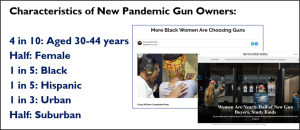
[24] According to the 2021 National Firearms Survey, from January 2019 to April 2021, 27.2 million US adults (1/10 of the population) bought a gun. This included 7.5 million new gun owners (28% of all gun buyers in this period). In 2020 alone, 1.5% of US adults became new gun owners (3.8 million people), and by the end of the study period, 10% of all gun owners had become gun owners since January 2019. Compared to existing gun owners, these new pandemic gun owners are younger, more female, more likely to have children, more likely to have never married, more African American and Hispanic, and more urban and suburban. They are also more likely to own only handguns, suggesting their self-defense orientation.[18]
[25] These data are remarkable for how clearly they reflect ongoing trends. Faced with social uncertainty and social unrest, it is not surprising that a broad swath of the American population would respond by buying guns. So many new and nontraditional gun owners reflect the changing face of gun ownership in America away from the Duck Dynasty or Oath Keeper stereotypes. They represent a vital part of the changing face and future of Gun Culture 2.0.[19]
GUN VIOLENCE PROPERLY UNDERSTOOD
Misunderstanding #3: There is an epidemic of gun violence in the United States
[26] Googling “gun violence epidemic” yields millions of results, from the media, advocacy groups, scholars, and interested others. “Epidemic” here should be seen as a rhetorical phrase meant to arouse concern about gun violence and mobilize efforts to “prevent,” “solve,” or “eradicate” it. This rhetoric, however, also perpetuates misunderstanding of the nature of gun violence.
[27] The Centers for Disease Control describes “an epidemic as an unexpected increase in the number of disease cases in a specific geographical area.”[20] What we see in the US, by contrast, are annual fluctuations in the rate of gun injury and death, and a long-term trend toward lower rates of both.
[28] In the following chart, sociologist Claude Fisher highlights the big picture of declining homicide rates in the US over three centuries. He and others also note that most interpersonal violence declined over this same period.[21]
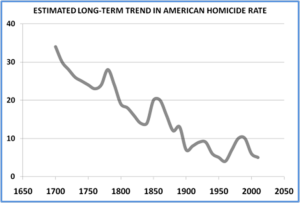
Source: Claude Fisher. 2010. “A Crime Puzzle: Violent Crime Declines in America.” Berkeley Blog (16 June).
[29] The gun violence that exists in America today is neither unexpected nor equally distributed demographically or geographically.
[30] Thus understood, gun violence presents a paradox: The US has higher rates of gun violence than other high-income nations, but most gun owners will not directly experience gun violence. This is due to our longstanding gun culture which facilitates a large proportion of our population owning guns and the huge number of guns in civilian hands.
[31] The infrequency of gun misuse can be seen in the following table, which gives the count of some significant negative outcomes with guns and the rate of those outcomes per gun owner (=76.5 million) and per gun (=400 million).[22]
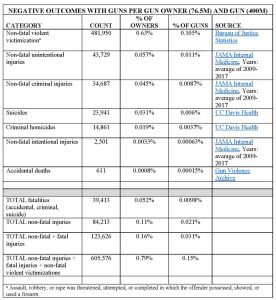
[32] Examining just the last row of this table, a mere 0.79% of gun owners and 0.15% of guns are involved in fatal or non-fatal injuries or victimization involving firearms annually. Looked at the other way around, 99.21% of gun owners and 99.85% of guns are NOT involved in fatal or non-fatal injuries or victimizations involving firearms annually.
[33] Gun culture and gun violence coexist but as different social worlds that overlap only in very particular and rare ways.[23]
Understanding: Gun injury and death are socially organized and endemic
[34] Rather than using the emotionally charged language of “epidemic,” it is more accurate and helpful to view gun violence in America as “endemic.” This means the problem “is consistently present but limited to a particular region.” If we add limited to particular demographic groups and behaviors to this definition, we can begin to understand how gun violence – like the violence that “has been ubiquitous in human history”[24] – is socially organized and unequally distributed. It is a health disparity.
[35] Many observe that the United States has the highest rate of gun violence in the developed world. Among 31 high-income members of the Organization for Economic Co-operation and Development (OECD), the US indeed has the highest per capita homicide rate. That is significant. But while aggregating data for the entire country helps us see some things, it blinds us from others.
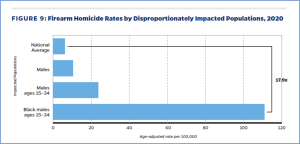
Source: Johns Hopkins Center for Gun Violence Solutions. 2022. “A Year in Review: 2020 Gun Deaths in the U.S.”
[36] First, it blinds us from the unequal demographic distribution of gun violence. According to a review of 2020 data by the Johns Hopkins Center for Gun Violence Solutions, gun homicide victimization’s endemic nature was evident in the fact that men were five times more likely to be victimized than women, Black people twelve times more likely than White people, Black men fifteen times more than White men, and Black women five times more than white women. At the intersection of this health inequality, we find Black males ages 15-34 with a 17.9 times higher rate of firearm homicide victimization than the national average (see figure above).[25]
[37] These demographic differences highlight the fact that when it comes to gun violence in the United States, no one lives in the United States. To properly understand this reality, we must consider the geography of “murder inequality” in America.[26] We live in 50 different states, some with higher rates of homicide (e.g., Mississippi, 17.9; Louisiana, 17.1) and some with lower rates (Idaho, 1.55; Massachusetts, 1.93). But we do not just live in one of 50 states, we live in one of over 3,000 particular counties or county-equivalents, some with rates of homicide higher than the national average (e.g., Phillips County, Arkansas, 55.4; Lowndes County, Alabama, 48.4) and as many as half of counties registering no homicides in any given year.[27]
[38] But we don’t just live in one of 3,000+ counties, we live in one of tens of thousands of cities, towns, villages, and unincorporated areas. Homicide rates in some localities are well above the national average (St. Louis, 88.1; New Orleans, 51.0; Detroit, 49.7; Memphis, 44.4), and even during the especially violent COVID year of 2020, there were cities in gun rich parts of the US that had lower than average homicide rates, like Scottsdale (Arizona) and Lincoln (Nebraska) at 2.7, and Plano (Texas) at 1.0. If the entire country had Plano’s homicide rate, the United States would rank #150 out of 195 countries in the world, rather than #60.[28]
[39] Moreover, even citywide averages can obscure the reality of murder inequality. We do not live in particular cities, but in particular neighborhoods. The Trace explored the issue of relative risk in St. Louis, the US city with one of the highest homicide rates in recent years. “The homicide rates in several neighborhoods in the city are so high,” The Trace reports, that “they exceeded those in Honduras, the deadliest country in the world.” At the same time, in other neighborhoods in St. Louis, “the risk is negligible.” St. Louis is one of the murder capitals of the United States, but some parts are as dangerous as San Pedro Sula and some as safe as Geneva.[29]
[40] It’s not surprising that we see these differences underlying the national average because some neighborhoods in the United States are like the developing world socio-economically, and some are like the developed world.
[41] Violent crime is so endemic that even neighborhoods can be too geographically broad. Criminologists today study “micro-geographic places”: particular street segments in particular neighborhoods. For example, as the figure above shows, 50% of crime in New York takes place on just over 4% of street segments.[30]
[42] As researchers from the Centers for Disease Control have observed, “firearm violence is not evenly distributed by geography or among the populations living in these communities. Rather it is highly concentrated in specific ‘hot spot’ locations and often occurs within high-risk social networks.” Andrew Papachristos utilizes the complex mathematical tools of network analysis to uncover these patterns of gun violence in communities. Papachristos shows that gun violence, while tragic, is rarely random; like a blood borne disease, it travels within social networks. In Boston’s Cape Verdean community, 85% of gunshot injuries took place in a network of just 6% of the population. In a high crime neighborhood in Chicago, 41% of homicides took place in a network of just 4% of the population.[31]
[43] This highlights the fact that even in high crime micro-geographic places, most residents are not directly involved in gun violence. This is not to say that gun violence in communities where it concentrates is not a significant problem. About 80% of people shot in criminal assaults survive. Beyond the physical and psychological traumas, they directly suffer is the broader trauma experienced by their family, friends, and communities. As Patrick Sharkey has documented, being in a violent neighborhood has many negative indirect effects, including PTSD, depression, decreased cognitive performance, and diminished attention and impulse control. That these disproportionately affect young people is even more reason for concern.[32]
Misunderstanding #4: Criminal homicides are the most common gun deaths in America
[44] As concerning as criminal gun violence is, Americans misunderstand how murder (and even more so, mass shootings) fit into the big picture of gun death in America. A 2019 survey reported by Heath Druzin using data from UC Davis found that 33% of respondents named murders and 25% named mass shootings as the most common form of firearm death. Only 23% correctly identified suicides as most common, even though they exceed murders by a 2-to-1 margin and mass killing victims by nearly 70-to-1 (see figure below).[33]
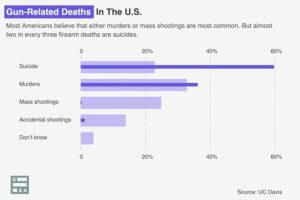
Source: Druzin, Heath. 2019. “The Majority Of U.S. Gun Deaths Are Suicides, But A New Poll Suggests Few Americans Know It.” Guns & America (1 October).
Understanding: The majority of gun deaths are suicides
[45] The United States ranks around 31st in the world with a suicide rate of 14.5 per 100,00 in 2021. Suicide is the 11th leading cause of death in the US overall and second leading cause among those 15-19 years old (comprising 21.5% of all deaths in that age category).
[46] Like homicide, the annual rate of suicide in the US has fluctuated considerably over time, with higher rates in the first half of the 20th century than the second half. From the 1970s to 2000, the suicide rate showed an overall pattern of decline, but from 2000 to 2018 it increased almost every year. Rates fell in 2019 and 2020 but increased again in 2021.[34]
[47] Firearms play a particular role in suicide in the US. The overall ratio of suicide attempts to suicides is 25-to-1 (a 4% case fatality rate), but for suicide attempts with firearms there is an 85% case fatality rate. Even though there are far fewer suicide attempts with firearms, just over half of completed suicides involve guns (54.6% in 2021).[35]
[48] Like criminal gun violence, there are clear social markers of suicide vulnerability, though the markers for suicide are considerably different than for homicide. Suicide concentrates among older, White and Indigenous men in the rural South and West, though rising rates among younger people and sexual/gender minorities are causes for additional concern.[36]
[49] Geographically, suicide clusters in states with laxer gun restrictions and higher rates of gun ownership. The 2021 suicide rate in Montana was 31.7 compared to 7.4 in New Jersey. Although establishing a clear causal link between gun laws/ownership and suicide is methodologically challenging, a recent prospective cohort study using data from California offers some significant insights. The study found that individuals who acquired a handgun had considerably higher rates of suicide by any method than those who did not (3.34 times higher for males and 7.16 times higher for females).
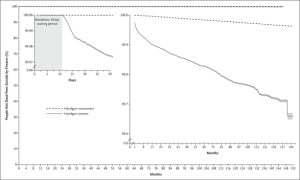
Source: David Studdert, et al. 2020. “Handgun Ownership and Suicide in California.” New England Journal of Medicine 382 (23): 2220–29.
[50] The figure above shows the probability of not dying by firearm suicide among handgun owners and nonowners over the study period. After 12 years, just over 99.6% of handgun owners had not committed suicide by firearm, compared to over 99.9% of handgun nonowners.[37] .[38] So, the relative risk of dying by suicide among handgun owners is greater than non-owners, but the absolute risk of dying by suicide for both groups is quite low. This is evident in the dashed and gray lines at the very top of this figure which show the odds of survival on a 0% to 100% scale.
[51] Without diminishing the significance of firearms as a risk factor for suicide or the trauma that suicide entails for survivors, this brings me back to my earlier point that most gun owners and those they live with will not experience self-harm with their firearms.
ADDRESSING NEGATIVE OUTCOMES
[52] Understanding gun violence as a health disparity concentrated in certain demographic groups, geographic areas, and behaviors suggests some approaches to addressing negative outcomes over others. The most promising immediate remedies see gun owners as part of the solution (rather than part of the problem) and focus on behaviors rather than guns, per se. Doing the latter also facilitates the former. Finally because criminal gun violence and suicide are health disparities, it is crucial to think beyond immediate remedies to address more fundamental root causes of the problem.
Criminal violence
[53] Understanding criminal gun violence as a micro-geographic and small network problem suggests highly focused interventions over general solutions. Criminologists like David Kennedy, Thomas Abt, and others suggest there are proven strategies to address gun violence that focus very specifically on the place, people, and behaviors where violence concentrates, rather than regulating or policing guns. These include community-based violence interruption programs like Chicago’s Cure Violence and focused deterrence programs like Boston’s Operation Ceasefire. Hospital-based violence intervention programs identify and provide resources to violent injury patients who are likely either to be re-injured or suffer physical and psychological trauma from their injuries. Simply fixing abandoned buildings and cleaning up vacant lots (“urban blight remediation”) has been shown to reduce crime and violence, especially in the most impoverished neighborhoods.[39]
[54] In addition to these immediate actions, more fundamental efforts must be made to address concentrated inequality including poverty, systemic racism (especially racial segregation), and lack of social investment in needy communities. These actions are mutually reinforcing, because reducing inequality reduces violence, and reducing violence helps reduce inequality.[40]
Self-harm
[55] As with criminal violence, self-harm must be addressed both immediately and in the long run. Immediate actions to reduce self-harm focus on creating distance between suicidal impulse and access to lethal means. Although much attention has been paid to the temporary surrender of firearms via Extreme Risk Protection Orders (“red flag” laws), there are a growing number of programs designed to make it easier for gun owners to voluntarily relinquish their firearms for a period. These include state firearms storage maps and non-profit groups like Hold My Guns, which identify locations (e.g., gun stores, law enforcement agencies) that are willing to consider temporary out-of-home gun storage for those in crisis. Additionally, three states have passed “Donna’s Law” (after Donna Nathan) which allows individuals to voluntarily place themselves on a do-not-sell list in their state’s background check system.
[56] Efforts are being made both within and outside of gun culture to educate gun owners about the importance of responsible storage of firearms to prevent unauthorized access. These include the National Shooting Sports Foundation’s Project ChildSafe and Brady United’s End Family Fire initiative.[41]
[57] More fundamentally, addressing the motivations for self-harm is important. This highlights the need to create safe spaces for gun owners to discuss their mental health without fear of losing their gun ownership rights, and to create cultural competency among mental health care providers to better understand guns and their owners. Walk the Talk America (https://walkthetalkamerica.org) was founded by gun industry veteran Michael Sodini for just this purpose.
[58] Talking about suicidality also needs to be destigmatized. The Overwatch+Project (https://overwatchproject.org/) is an educational campaign to normalize military veterans talking to one another about suicide. Based on the earlier successful “Friends Don’t Let Friends Drive Drunk” campaign, their call-to-action is for veterans to “just fucking ask” (JFA) what their fellow veterans’ mental state is and what plan they have for their firearms if they are suicidal.
[59] Of course, there are any number of policies that use the coercive power of the state to regulate firearms themselves to reduce gun violence.[42] But these policies often regulate unproblematic gun owners and so get caught up in the divisive and frequently gridlocked politics of guns in America. The policies proposed here are less controversial among gun owners and still have immediate beneficial effects.
NOTES
[1] Lindgren, James. 2002. “Fall from Grace: Arming America and the Bellesiles Scandal.” The Yale Law Journal 111 (8): 2195–2249.
[2] Haag, Pamela. 2016. The Gunning of America: Business and the Making of American Gun Culture. New York: Basic Books; Busse, Ryan. 2021. Gunfight: My Battle Against the Industry That Radicalized America. New York: PublicAffairs.
[3] Lindgren, James, and Justin Heather. 2002. “Counting Guns in Early America.” William & Mary Law Review 43 (5): 1777–1842.
[4] Kohn, Abigail. 2004. Shooters: Myths and Realities of America’s Gun Cultures. New York: Oxford University Press; Yamane, David. 2017. “The Sociology of U.S. Gun Culture.” Sociology Compass 11 (7): e12497. https://doi.org/10.1111/soc4.12497.
[5] These realities are the subject of numerous popular and scholarly histories including Anderson, Carol. 2021. The Second: Race and Guns in a Fatally Unequal America. New York: Bloomsbury; Dunbar-Ortiz, Roxanne. 2018. Loaded: A Disarming History of the Second Amendment. San Francisco: City Lights; and Harsanyi, David. 2018. First Freedom: A Ride Through America’s Enduring History with the Gun. New York: Threshold Editions.
[6] Cramer, Clayton E. 2006. Armed America: The Remarkable Story of How and Why Guns Became as American As Apple Pie. Nashville, TN: Nelson Current, p. 236.
[7] Tonso, William. 1982. Gun and Society: The Social and Existential Roots of the American Attachment to Firearms. Washington, DC: University Press of America.
[8] Miyan, Randy. 2021. The Liberal Gun Owner Lens, Pillar 1: The Human-Weapon Relationship. Retrieved on 14 January 2023 from https://lgolens.com/anthropillar/.
[9] Yamane, David. 2023 (forthcoming). “Gun Culture 2.0: The Evolution and Contours of Defensive Gun Ownership in America.” The ANNALS of the American Academy of Political and Social Science.
[10] Yamane, David, Paul Yamane, and Sebastian L. Ivory. 2020. “Targeted Advertising: Documenting the Emergence of Gun Culture 2.0 in Guns Magazine, 1955–2019.” Palgrave Communications 6 (1): 1–9.
[11] No one knows what proportion of the U.S. population actually owns guns. As with religion, the federal government does not keep official records or collect statistics on gun ownership. So, we depend on surveys conducted by organizations like Gallup, the Pew Research Center, National Opinion Research Center, and others. These surveys not only produce different estimates, but they also underestimate gun ownership rates. My educated guess is that 33-37% of adults personally own guns and 44-50% of households have guns in them.
[12] Parker, Kim, Juliana Menasce Horowitz, Ruth Igielnik, Baxter Oliphant, and Anna Brown. 2017. “America’s Complex Relationship With Guns.” Pew Research Center (blog). June 22, 2017. http://www.pewsocialtrends.org/2017/06/22/americas-complex-relationship-with-guns/.
[13] Cottrol, Robert, and Raymond Diamond. 1991. “The Second Amendment: Toward an Afro-Americanist Reconsideration.” Georgetown Law Journal 80: 309–61; Johnson, Nicholas. 2014. Negroes and the Gun: The Black Tradition of Arms. Amherst, NY: Prometheus Books; Browder, Laura. 2006. Her Best Shot: Women and Guns in America. Chapel Hill: University of North Carolina Press.
[14] Cooter, Amy. 2022. “Citizen Militias in the U.S. Are Moving toward More Violent Extremism.” Scientific American (1 January). Retrieved on 11 February 2023 from https://doi.org/10.1038/scientificamerican0122-34.
[15] Azrael, Deborah, et al. 2017. “The Stock and Flow of US Firearms: Results from the 2015 National Firearms Survey.” Russell Sage Foundation Journal of the Social Sciences 3 (5): 38–57.
[16] Wertz, Joseph, et al. 2018. “Differences Between New and Long-Standing US Gun Owners: Results from a National Survey.” American Journal of Public Health 108 (7): 871–77.
[17] National Shooting Sports Foundation. 2021. “Taking Stock of Record-Setting 2020 Firearm Year.” NSSF Blog (January 7). Retrieved on 15 January 2023 from https://www.nssf.org/articles/taking-stock-of-record-setting-2020-firearm-year/; Kravitz-Wirtz, Nicole, et al. 2021. “Public Concern About Violence, Firearms, and the COVID-19 Pandemic in California.” JAMA Network Open 4 (1): e2033484.
[18] Miller, Matthew, Wilson Zhang, and Deborah Azrael. 2022. “Firearm Purchasing During the COVID-19 Pandemic: Results From the 2021 National Firearms Survey.” Annals of Internal Medicine 175 (2): 219–25.
[19] Yamane, David. 2021. “Gun Culture 2.0 and the Great Gun-Buying Spree of 2020,” Discourse (2 February). Retrieved on 25 January 2023 from https://www.discoursemagazine.com/culture-and-society/2021/02/02/gun-culture-2-0-and-the-great-gun-buying-spree-of-2020/.
[20] Columbia University, Mailman School of Public Health, “Epidemic, Endemic, Pandemic: What Are the Differences?” 2021 (February 19). Accessed 16 January 2023 from https://www.publichealth.columbia.edu/public-health-now/news/epidemic-endemic-pandemic-what-are-differences.
[21] Claude Fisher. 2010. “A Crime Puzzle: Violent Crime Declines in America” (16 June). Retrieved on 16 January 2023 from http://blogs.berkeley.edu/2010/06/16/a-crime-puzzle-violent-crime-declines-in-america. See also Pinker, Steven. 2011. The Better Angels of Our Nature: Why Violence Has Declined. New York: Viking.
[22] Data from 2019 unless otherwise indicated, excluding legal interventions and justifiable defensive gun use. The number of gun owners here is 30% of 255.2 million adults in 2019 (Pew Research Center and US Census Bureau) and the number of guns is from the Small Arms Survey. No one knows what proportion of the U.S. population actually owns guns. As with religion, the federal government does not keep official records or collect statistics on gun ownership. So, we depend on surveys conducted by organizations like Gallup, the Pew Research Center, National Opinion Research Center, and others. These surveys not only produce different estimates, but I argue they also underestimate gun ownership rates. My educated guess is that 33-37% of adults personally own guns.
[23] Legault, Richard L., et al. 2019. “Caught in a Crossfire: Legal and Illegal Gun Ownership in America.” In Handbook on Crime and Deviance, edited by Marvin D. Krohn, et al. New York: Springer, p. 533.
[24] Ray, Larry. 2011. Violence and Society. Los Angeles: Sage, p. 23.
[25] Johns Hopkins Center for Gun Violence Solutions. 2022. A Year in Review: 2020 Gun Deaths in the U.S. Retrieved on 17 January 2023 from https://publichealth.jhu.edu/sites/default/files/2022-05/2020-gun-deaths-in-the-us-4-28-2022-b.pdf.
[26] Hertz, Daniel Kay. 2016. “The Debate Over Crime Rates Is Ignoring the Metric That Matters Most: ‘Murder Inequality’.” The Trace (25 July). Retrieved on 20 January 2023 from https://www.thetrace.org/2016/07/murder-inequality-urban-violence-statistics/.
[27] Johns Hopkins, supra note 24.
[28] “List of Countries by Intentional Homicide Rate,” Wikipedia. Retrieved on 20 January 2023 from https://en.wikipedia.org/wiki/List_of_countries_by_intentional_homicide_rate.
[29] Team Trace. 2017. “15 Census Tracts, 97 Fatal Shootings, and the Two Different Sides to American Gun Violence.” The Trace (22 March). Retrieved on 20 January 2023 from https://www.thetrace.org/2017/03/gun-violence-deadliest-census-tracts/.
[30] Aaron Chalfin, et al. 2021. “Measuring Marginal Crime Concentration: A New Solution to an Old Problem.” Journal of Research in Crime and Delinquency 58 (4): 467–504
[31] Fowler, Katherine A., et al. 2015. “Firearm Injuries in the United States.” Preventive Medicine 79 (October), p. 11; Papachristos, Andrew V., et al. 2012. “Social Networks and the Risk of Gunshot Injury.” Journal of Urban Health 89 (6): 992–1003; Papachristos, Andrew V., and Christopher Wildeman. 2014. “Network Exposure and Homicide Victimization in an African American Community.” American Journal of Public Health 104 (1): 143–50.
[32] Armstrong, Madison, and Jennifer Carlson. 2021. “We’ve Spent Over a Decade Researching Guns in America. This Is What We Learned.” New York Times (26 March). Retrieved on 20 January 2023 from https://www.nytimes.com/2021/03/26/opinion/politics/gun-reform-us.html; Lee, Jooyoung. 2012. “Wounded: Life after the Shooting.” The ANNALS of the American Academy of Political and Social Science 642 (1): 244–57; Sharkey, Patrick. 2018. Uneasy Peace: The Great Crime Decline, the Renewal of City Life, and the Next War on Violence. New York: W. W. Norton.
[33] Druzin, Heath. 2019. “The Majority Of U.S. Gun Deaths Are Suicides, But A New Poll Suggests Few Americans Know It.” Guns & America (1 October). Retrieved on 20 January 2023 from https://gunsandamerica.org/story/19/10/01/the-majority-of-u-s-gun-deaths-are-suicides-but-a-new-poll-suggests-few-americans-know-it/.
[34] Martínez-Alés, Gonzalo, et al. 2022. “The Recent Rise of Suicide Mortality in the United States.” Annual Review of Public Health 43 (1): 99–116.
[35] Drapeau, C. W., & McIntosh, J. L. 2023. U.S.A. Suicide: 2021. Suicide Awareness Voices of Education (SAVE). Retrieve on 20 January 2023 from https://save.org/about-suicide/suicide-statistics.
[36] Martínez-Alés, et al., supra note 33.
[37] Studdert, David, et al. 2020. “Handgun Ownership and Suicide in California.” New England Journal of Medicine 382 (23): 2220–29.
[38] Studdert, David, et al. 2020. “Handgun Ownership and Suicide in California.” New England Journal of Medicine 382 (23): 2220–29.
[39] Kennedy, David M. 2012. Don’t Shoot: One Man, A Street Fellowship, and the End of Violence in Inner-City America. New York: Bloomsbury; Abt, Thomas. 2019. Bleeding Out: The Devastating Consequences of Urban Violence–and a Bold New Plan for Peace in the Streets. New York: Basic Books. Richardson, Joseph B., et al. 2020. “Shook Ones: Understanding the Intersection of Nonfatal Violent Firearm Injury, Incarceration, and Traumatic Stress Among Young Black Men.” American Journal of Men’s Health 14 (6): 1557988320982181; Branas, Charles C., et al. 2018. “Citywide Cluster Randomized Trial to Restore Blighted Vacant Land and Its Effects on Violence, Crime, and Fear.” Proceedings of the National Academy of Sciences 115 (12): 2946–51.
[40] “Want to Fix Gun Violence in America? Go Local.” The Guardian (9 January 2017). http://www.theguardian.com/us-news/ng-interactive/2017/jan/09/special-report-fixing-gun-violence-in-america; Thomas Abt, supra note 37.
[41] Kelly, Timothy, et al. 2020. “Firearm Storage Maps: A Pragmatic Approach to Reduce Firearm Suicide During Times of Risk.” Annals of Internal Medicine 172 (5): 351–53; Vars, Fredrick E. 2020. “Voluntary Do-Not-Sell Lists — An Innovative Approach to Reducing Gun Suicides.” New England Journal of Medicine 383 (14): 1299–1301.
[42] See the RAND Corporation’s “Gun Policy in America” initiative at https://www.rand.org/research/gun-policy.html.


